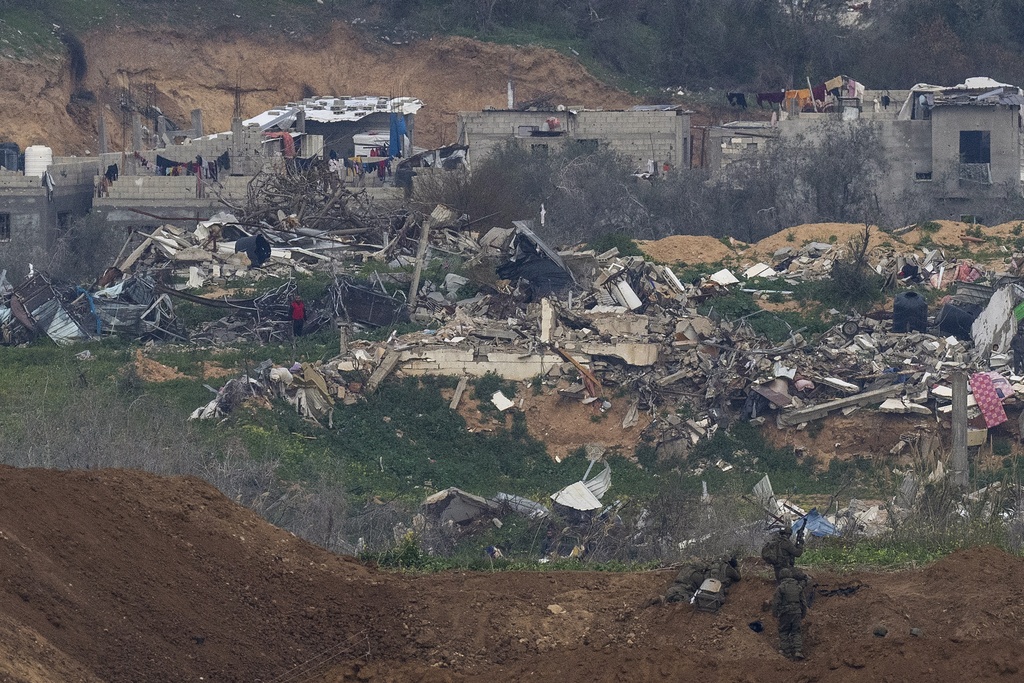MUGHRAQA, Gaza Strip (AP) — There is renewed pressure Sunday on Israeli Prime Minister Benjamin Netanyahu to extend a fragile Gaza ceasefire beyond the first phase, and US President Donald Trump repeated his pledge that the US would take control of the Palestinian enclave.
Talks on the second phase, meant to see more hostages released and a complete Israeli withdrawal from Gaza, were due to start Feb. 3. But Israel and Hamas appear to have made little progress, even as Israeli forces withdrew Sunday from a Gaza corridor in the latest commitment to the truce.
Netanyahu sent a delegation to Qatar, a key mediator, but it included low-level officials, sparking speculation that it won’t lead to a breakthrough. Netanyahu, who returned after a US visit to meet with Trump, is expected to convene security Cabinet ministers on Tuesday.
Trump weighs in on Gaza again
Speaking on Sunday, Trump repeated his pledge to take control of the Gaza Strip.
“I’m committed to buying and owning Gaza. As far as us rebuilding it, we may give it to other states in the Middle East to build sections of it. Other people may do it through our auspices. But we’re committed to owning it, taking it, and making sure that Hamas doesn’t move back. There’s nothing to move back into. The place is a demolition site. The remainder will be demolished,” he told reporters onboard Air Force One as he traveled to the Super Bowl.

Trump said Arab nations would agree to take in Palestinians after speaking with him and insisted Palestinians would leave Gaza if they had a choice.
“They don’t want to return to Gaza. If we could give them a home in a safer area — the only reason they’re talking about returning to Gaza is they don’t have an alternative. When they have an alternative, they don’t want to return to Gaza.”
Trump also suggested he was losing patience with the deal after seeing the hostages released this week. Israel has expressed openness to the idea of resettling Gaza’s population — “a revolutionary, creative vision,” Netanyahu told his Cabinet on Sunday — while Hamas, the Palestinians and much of the world have rejected it.
Egypt said it will host an emergency Arab summit on Feb. 27 to discuss the “new and dangerous developments.”
Trump’s proposal has moral, legal and practical obstacles. It may have been proposed as a negotiation tactic to pressure Hamas or an opening gambit in discussions aimed at securing a normalisation deal between Israel and Saudi Arabia.
Saudi Arabia condemned Netanyahu’s recent comment that Palestinians could create their state there, saying it aimed to divert attention from crimes committed by “the Israeli occupation against our Palestinian brothers in Gaza, including the ethnic cleansing they are being subjected to.”
Qatar called Netanyahu’s comment “provocative” and a blatant violation of international law.
The ceasefire’s extension is not guaranteed
The ceasefire that began on Jan 19 has held, raising hopes that the 16-month war that led to seismic shifts in the Middle East may be headed toward an end.
The latest step was Israel forces’ withdrawal from the 4-mile (6-kilometer) Netzarim corridor separating northern and southern Gaza, which was used as a military zone. No troops were seen in the vicinity Sunday. As the ceasefire began last month, Israel began allowing hundreds of thousands of displaced Palestinians to cross Netzarim and return to the north.
But the deal remains fragile. On Sunday, civil defense first responders in Gaza said Israeli fire killed three people east of Gaza City. Israel’s military noted “several hits” after firing warning shots and warned Palestinians against approaching its forces.
Cars piled with belongings headed north. Under the deal, Israel should allow cars to cross Netzarim uninspected. Troops remain along Gaza’s borders with Israel and Egypt.
Hamas spokesperson Abdel Latif Al-Qanoua said the troops’ withdrawal showed the militant group had “forced the enemy to submit to our demands” and thwarted “Netanyahu’s illusion of achieving total victory.”
Israel has said it won’t agree to a complete withdrawal from Gaza until Hamas’ military and political capabilities are eliminated. Hamas says it won’t hand over the last hostages until Israel removes all troops.
During the ceasefire’s 42-day first phase, Hamas is gradually releasing 33 Israeli hostages captured. Israel has said Hamas confirmed that eight of the 33 are dead.
Families of the hostages gathered in Tel Aviv to urge Netanyahu to extend the ceasefire, but he is also under pressure from far-right political allies to resume the war. Trump’s proposal for the US to take control of the Gaza Strip may also complicate the situation.
The war in Gaza has killed more than 47,000 Palestinians, according to local health authorities, who do not differentiate between fighters and noncombatants in their count.
Much of the territory has been obliterated.
Violence in the occupied West Bank
Violence has surged in the occupied West Bank during the war and intensified in recent days with an Israeli military operation against Palestinian militants in the territory’s north.
On Sunday, the Palestinian Health Ministry said Israeli gunfire killed two women, one of them, Sundus Shalabi, eight months pregnant. It said Rahaf al-Ashqar, 21, was also killed. The shooting occurred in the Nur Shams urban refugee camp, a focal point of Israeli operations.
Israel’s Defense Minister Israel Katz on Sunday announced the expansion of the operation that started in Jenin several weeks ago. He said it was meant to prevent Iran — allied with Hamas — from establishing a foothold in the West Bank.







